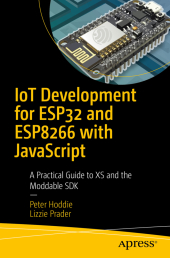 Neuerscheinungen 2020Stand: 2020-02-01 |
Schnellsuche
ISBN/Stichwort/Autor
|
Herderstraße 10
10625 Berlin
Tel.: 030 315 714 16
Fax 030 315 714 14
info@buchspektrum.de |

Peter Hoddie, Lizzie Prader
(Beteiligte)
IoT Development for ESP8266 and ESP32 with JavaScript
Build Powerful Software with New Generation Hardware
1st ed. 2020. xx, 280 S. 235 mm
Verlag/Jahr: SPRINGER, BERLIN; APRESS 2020
ISBN: 1-484-25069-9 (1484250699)
Neue ISBN: 978-1-484-25069-3 (9781484250693)
Preis und Lieferzeit: Bitte klicken
Learn IoT programming using modem JavaScript on the ESP8266 and its more powerful successor, the ESP32. This book teaches you how to implement common connectivity features of IoT products using Wi-Fi, HTTP, WebSockets, MQTT, mDNS, and secure communications as well as how to work with common sensors and actuators over Digital, I2C, and SPI connections.
You´ll be introduced to graphics and building touch user interfaces for IoT applications with this new hardware generation that is powerful enough to handle color touch screens. Along the way, tips and techniques are given for using JavaScript to get the most from the memory and performance available on the latest IoT hardware. More importantly, you´ll see how to apply JavaScript programming language to combine diverse technologies - networking, user interfaces, sensors, actuators, and product logic -into a reliable, maintainable application at the heart of an IoT product.
IoT Development for ESP8266 and ESP32 with JavaScript introduces a new approach to IoT software development based on JavaScript and pairs it with a new generation of IoT hardware.
What You´ll Learn
Develop JavaScript applications for the ESP8266 and ESP32 microcontrollers using the Moddable SDK
Write modern JavaScript applications for microcontrollers
Work with fundamental developer tools for ESP8266/ESP32 development
Graphics and GUI development for IoT products
Add asynchronous (non-blocking) network connections to embedded apps
Who This Book Is For
People interested in getting started with JavaScript development on microcontrollers; JavaScript developers working on web or server-side applications; Embedded developers working with hardware
Peter Hoddie is an engineer and entrepreneur focused on client software. He is recognized for crafting compact and efficient code that pushes the boundaries of user experience on consumer hardware. The software he and his teams have built has powered mass-market consumer products from companies including Apple, Palm, Sling, HP, and Sony. Peter recognizes that the first users of any product are the developers creating it, and that those developers cannot build compelling consumer products on a foundation that´s unstable, complex, or confusing. He therefore champions investments in great tools and a simple runtime architecture.
Peter has founded several companies, including Kinoma, which merged into Marvell Semiconductor. He led QuickTime development at Apple during the 1990s as a Distinguished Engineer. He contributed to the development of the QuickTime file format and its adoption by ISO into the MPEG-4 standard. He is currently a member of the JavaScript language standards committee (ECMA TC39) and chair of ECMA TC53 for "Smart wearable systems and sensor-based devices". Peter is particularly proud of his work putting both the KinomaJS framework and Darwin Streaming Server into open source. He continues to come to terms with the 10 patents that bear his name.
Lizzie Prader is an engineer whose educational background is in theoretical computer science, but is currently better described as an engineer focused on developers´ needs. She recognizes the importance of customer support during all stages of a project, and enjoys working with developers to smooth the on-ramp to embedded development. Working with users of all skill levels-from professional engineers to makers and hobbyists to absolute programming beginners-has made her an advocate of well-organized documentation and readable code.
Prior to Moddable, Lizzie worked as a developer relations engineer at Kinoma. Her main goal was to help customers get the most out of Kinoma´s software and hardware prototyping products, both through direct contact with developers and by creating a variety of resources including sample code, tutorials, and blog posts


